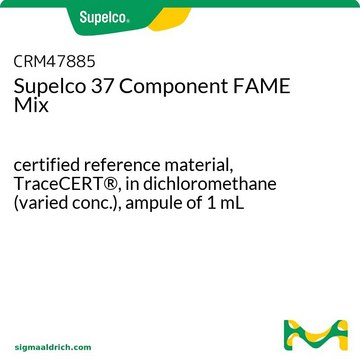W245115
Ethyl palmitate
natural (US), ≥95%, FG
Sinónimos:
Ethyl hexadecanoate, Palmitic acid ethyl ester
About This Item
Productos recomendados
grado
FG
Fragrance grade
Halal
Kosher
natural (US)
Agency
follows IFRA guidelines
cumplimiento norm.
EU Regulation 1223/2009
EU Regulation 1334/2008 & 178/2002
FDA 21 CFR 117
Ensayo
≥95%
índice de refracción
n20/D 1.440 (lit.)
bp
192-193 °C/10 mmHg (lit.)
mp
24-26 °C (lit.)
densidad
0.857 g/mL at 25 °C (lit.)
aplicaciones
flavors and fragrances
Documentación
see Safety & Documentation for available documents
alérgeno alimentario
no known allergens
alérgeno de la fragancia
no known allergens
Organoléptico
creamy; milk; fruity; waxy
cadena SMILES
CCCCCCCCCCCCCCCC(=O)OCC
InChI
1S/C18H36O2/c1-3-5-6-7-8-9-10-11-12-13-14-15-16-17-18(19)20-4-2/h3-17H2,1-2H3
Clave InChI
XIRNKXNNONJFQO-UHFFFAOYSA-N
¿Está buscando productos similares? Visita Guía de comparación de productos
Código de clase de almacenamiento
10 - Combustible liquids
Clase de riesgo para el agua (WGK)
WGK 3
Punto de inflamabilidad (°F)
Not applicable
Punto de inflamabilidad (°C)
Not applicable
Elija entre una de las versiones más recientes:
¿Ya tiene este producto?
Encuentre la documentación para los productos que ha comprado recientemente en la Biblioteca de documentos.
Nuestro equipo de científicos tiene experiencia en todas las áreas de investigación: Ciencias de la vida, Ciencia de los materiales, Síntesis química, Cromatografía, Analítica y muchas otras.
Póngase en contacto con el Servicio técnico







